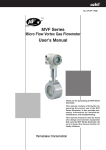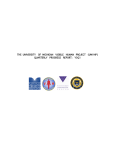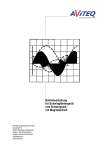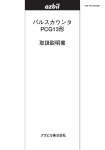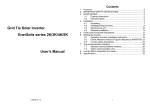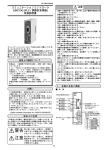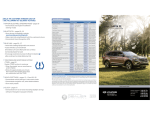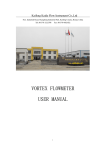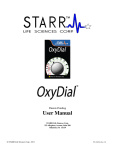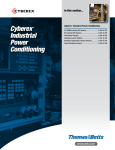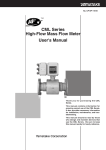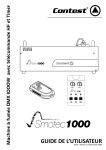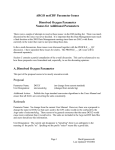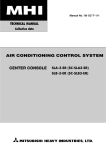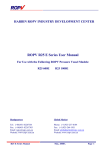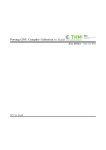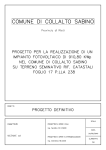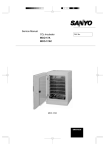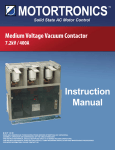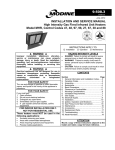Download MVF Series User`s Manual
Transcript
No. CP-SP-1190E TM MVF Series Micro Flow Vortex Gas Flowmeter User's Manual Thank you for purchasing an MVF Series flowmeter. This manual contains information for ensuring the correct use of the MVF Series flowmeter. It also provides necessary information for installation, maintenance, and troubleshooting. This manual should be read by those who design and maintain equipment that uses the MVF Series flowmeter. Be sure to keep this manual nearby for handy reference. RESTRICTIONS ON USE This product has been designed, developed and manufactured for general-purpose application in machinery and equipment. Accordingly, when used in applications outlined below, special care should be taken to implement a fail-safe and/or redundant design concept as well as a periodic maintenance program. • Safety devices for plant worker protection • Start/stop control devices for transportation and material handling machines • Aeronautical/aerospace machines • Control devices for nuclear reactors Never use this product in applications where human safety may be put at risk. NOTICE Be sure that the user receives this manual before the product is used. Copying or duplicating this user’s manual in part or in whole is forbidden. The information and specifications in this manual are subject to change without notice. Considerable effort has been made to ensure that this manual is free from inaccuracies and omissions. If you should find an error or omission, please contact Yamatake Corporation. In no event is Yamatake Corporation liable to anyone for any indirect, special or consequential damages as a result of using this product. ©2005 Yamatake Corporation ALL RIGHTS RESERVED TM TM µF and Micro Flow are trademarks of Yamatake Corporation in Japan. SAFETY PRECAUTIONS ■ About Icons The safety precautions described in this manual are indicated by various icons. Please be sure you read and understand the icons and their meanings described below before reading the rest of the manual. Safety precautions are intended to ensure the safe and correct use of this product, to prevent injury to the operator and others, and to prevent damage to property. Be sure to observe these safety precautions. WARNING CAUTION Warnings are indicated when mishandling this product might result in death or serious injury. Cautions are indicated when mishandling this product might result in minor injury to the user, or only physical damage to the product. ■ Examples Triangles warn the user of a possible danger that may be caused by wrongful operation or misuse of this product. These icons graphically represent the actual danger. (The example on the left warns the user of the danger of electric shock.) White circles with a diagonal bar notify the user that specific actions are prohibited to prevent possible danger. These icons graphically represent the actual prohibited action. (The example on the left notifies the user that disassembly is prohibited.) Filled-in black circles instruct the user to carry out a specific obligatory action to prevent possible danger. These icons graphically represent the actual action to be carried out. (The example on the left instructs the user to remove the plug from the outlet.) i WARNING If this device is used with flammable gases such as natural gas, propane or butane, mount it on the upstream side of the safety shutoff valve. When air gets in the pipe and an explosive mixture is produced, and if a sensor should make a spark due to lightning or other reasons, the mixture may explode inside the pipe. The mass of this device is 7 to 23kg according to the model number. Ensure to take complete precautions and care while handling for transportation or installation. For safe handling, two or more persons are required while handling this device. Accidental dropping of the device on the foot might cause injury. Do not hold the device by the converter alone. Doing so might damage the device, or the pipe connector section may drop off. Do not use this device or its installed pipes as a scaffolding. Doing so might damage the device or the pipe, or might cause physical injury. Do not disassemble this device. If it is disassembled when pressure remains in the pipes, the device could be damaged or someone could be injured by flying parts. CAUTION Be sure that the operating gas temperature does not fall below -15°C. Using the gas below -15°C, the O-ring might crack and cause gas leakage. Prevent foreign matter from entering the device. If the rust, water droplet, oil mist or dust in the piping flows into the device, measurement error might occur and result in damaging the device. If there is a possibility that any foreign matter flows into the device, provide a filter, strainer or mist trap capable of eliminating more than 1µm foreign matter at the upstream, and periodically inspect and replace the filter. If this device is used for monitoring flowrate of the burner, consider the piping instrumentation lest the backfire damage this device. When connecting the load to the output terminals, do not exceed the rated value shown in the specifications. Doing so might cause the damage of this device. ii CAUTION This device is a precision instrument. Do not drop it or subject it to shock. Doing so might damage the device. When connecting flanges, tighten with the specified torque. Otherwise gas could leak from the pipe, causing injury. When mounting the device, firmly fasten to prevent vibration. Do not peel off the pipe connector port seals until immediately before you connect the piping. Doing so might allow foreign objects to enter the connector port and cause defective operation. Do not flush when the device is mounted in the pipe. Doing so might cause damage due to entry of foreign matter and cause faulty operation or errors in measurement. Before wiring, be sure to turn the power OFF. Before supplying power, be sure to check that there is no wiring error. A wiring error might damage the device or cause a dangerous condition. Do not use this device outside of the operating pressure range. Also, do not subject this device to a pressure above the pressure resistance. Doing so might damage this device. iii Organization of This User's Manual This manual is organized as follows: Chapter 1. INTRODUCTION This chapter describes features on this device. Chapter 2. NAMES AND FUNCTIONS OF PARTS This chapter describes the NAMES AND FUNCTIONS OF PARTS on this device. Chapter 3. INSTALLATION, MOUNTING, WIRING This chapter describes installation, mounting and wiring on this device. Chapter 4. TROUBLESHOOTING This chapter describes how to investigate and remedy trouble that may occur during operation of this device. Chapter 5. SPECIFICATIONS This chapter describes the specifications and external dimensions of this device. Conventions Used in This Manual The following conventions are used in this manual: Handling Precautions: Handling Precautions indicate items that the user should pay attention to when handling the MVF Series. Note: : Notes indicate information that might benefit the user. This indicates the item or page that the user is requested to refer to. (1), (2), (3): Numbers within parentheses indicate steps in a sequence or parts of an explanation. AL01: 1000.0 This indicates 7-segment indication on the display. iv Contents SAFETY PRECAUTIONS Organization of This User's Manual Conventions Used in This Manual Chapter 1. INTRODUCTION ■ ■ ■ ■ Chapter 2. Introduction • • • • • • • • • • • • • • • • • • • • • • • • • • • • • • • • • • • • • • • • • • • • • • • • • • • • • • • • • • • • • 1 Features • • • • • • • • • • • • • • • • • • • • • • • • • • • • • • • • • • • • • • • • • • • • • • • • • • • • • • • • • • • • • • • • • 1 System • • • • • • • • • • • • • • • • • • • • • • • • • • • • • • • • • • • • • • • • • • • • • • • • • • • • • • • • • • • • • • • • • • 1 Model selection table • • • • • • • • • • • • • • • • • • • • • • • • • • • • • • • • • • • • • • • • • • • • • • • • • • • • 2 NAMES AND FUNCTIONS OF PARTS ■ Body • • • • • • • • • • • • • • • • • • • • • • • • • • • • • • • • • • • • • • • • • • • • • • • • • • • • • • • • • • • • • • • • • • • • • 3 ■ Display • • • • • • • • • • • • • • • • • • • • • • • • • • • • • • • • • • • • • • • • • • • • • • • • • • • • • • • • • • • • • • • • • • 4 Chapter 3. INSTALLATION, MOUNTING, WIRING ■ ■ ■ ■ Chapter 4. Installation • • • • • • • • • • • • • • • • • • • • • • • • • • • • • • • • • • • • • • • • • • • • • • • • • • • • • • • • • • • • • • 6 Precautions for piping installation • • • • • • • • • • • • • • • • • • • • • • • • • • • • • • • • • • • • • • 6 Piping work • • • • • • • • • • • • • • • • • • • • • • • • • • • • • • • • • • • • • • • • • • • • • • • • • • • • • • • • • • • • • • 9 Wiring • • • • • • • • • • • • • • • • • • • • • • • • • • • • • • • • • • • • • • • • • • • • • • • • • • • • • • • • • • • • • • • • • • 11 TROUBLESHOOTING ■ Nothing on display • • • • • • • • • • • • • • • • • • • • • • • • • • • • • • • • • • • • • • • • • • • • • • • • • • • • • 15 ■ Error message (faulty operation) • • • • • • • • • • • • • • • • • • • • • • • • • • • • • • • • • • • • • • • 15 ■ Alarm display • • • • • • • • • • • • • • • • • • • • • • • • • • • • • • • • • • • • • • • • • • • • • • • • • • • • • • • • • • 16 Chapter 5. SPECIFICATIONS ■ ■ ■ ■ Specifications • • • • • • • • • • • • • • • • • • • • • • • • • • • • • • • • • • • • • • • • • • • • • • • • • • • • • • • • • • 17 Specifying accuracy • • • • • • • • • • • • • • • • • • • • • • • • • • • • • • • • • • • • • • • • • • • • • • • • • • • 18 Tables for specifying volumetric flow rate accuracy (in air) • • • • • • • • • • • • 21 Tables for accuracy after temperature and pressure • • • • • • • • • • • • • • • • • • • 22 compensation (in air) ■ Pressure loss • • • • • • • • • • • • • • • • • • • • • • • • • • • • • • • • • • • • • • • • • • • • • • • • • • • • • • • • • • 24 ■ External dimensions • • • • • • • • • • • • • • • • • • • • • • • • • • • • • • • • • • • • • • • • • • • • • • • • • • • 25 v Chapter 1. INTRODUCTION ■ Introduction The MVF Series Micro Flow Vortex Gas Flowmeter (hereafter called "the device" or "the MVF") is a thermal vortex gas flowmeter featuring a wide measurement range. It uses the Yamatake-designed Micro Flow sensor (or "µF sensor") as a vortex generator. ■ Features • 35% more of the MVF's component materials are available for re-use or recycling, as compared with the conventional CMK model. • Temperature and pressure compensation functions are integrated into the MVF. Since expensive temperature and pressure compensation devices are not required, a large cost reduction can be expected. • This device incorporates a µF (Micro Flow) sensor a mere 1.7mm square and 0.5mm thick, made possible by silicon micro-machining and thin-film technologies. By using this high-sensitivity, high-speed sensor to detect vortex frequency, measurement rangeability of 100:1 has been achieved. • The entire MVF is provided with wide range of functions to meet various applications needs: LCD display function, analog output (4 to 20mA), integrating calculation, display and integral pulse output (open collector). Also, an RS-485 communications function is provided as a standard feature, so a large amount of instrumentation cost reduction can be achieved when data is uploaded. ■ System Pulse counter PCG13 put MVF e uls out Personal computer etc. P CMC10L LOADER RS-232C power SD RD HOST CMC CMC ADDRESS Communications (RS-485) HOST CMC B.RATE RD CMC LOCAL SD 11 12 13 14 ERR 15 RESET CMC10 Smart terminal EST-Z series PLC 4 to 20mA instantaneous flow rate output Controller SDC series etc. 1 Chapter 1. INTRODUCTION ■ Model selection table The following shows the model Nos. for this flowmeter: Basic model No. Pipe size Model Material Connecti- Gas type on method type Output Power Commu- Flow and moun- Option 1 Option 2 Appended nication ting direction MVF Descripton Micro Flow Vortex Flowmeter Pipe size 50A (2B) Pipe size 80A (3B) Pipe size 100A (4B) Pipe size 150A (6B) With temperature/pressure compensation function Without pressure compensation but with temperature compensation Material SUS304 JIS/ANSI wafer Air, Nitrogen, Algon Oxygen (Be sure to specify code "1" in the opiton 1 gas-contacting parts treated to be oil free) *1 Carbondioxide Natural gas (LNG base), Methane Propane Butane 4 to 20mAdc output + Integration pulse output Power 24Vdc RS-485 Communication (EST, WEB100, CMC10G communication) Horizontal (Flow direction:left to right) Converter on top *2 Horizodntal (Flow direction:left to right) Converter on bottom *2 Horizontal (Flow direction:right to left) Converter on top *2 Horizontal (Flow direction:right to left) Converter on bottom *2 Vertical (Flow direction:down to up) Converter on left *2 Vertical (Flow direction:up to down) Converter on left *2 Option 1 none Gas-contacting parts treated to be oil free (Necessary if gas type is oxygen) *1 Option 2 none Product version 050 080 100 150 0 L S U N S C G P B 0 1 1 0 1 2 3 4 5 0 1 0 0 *1: If the gas type is oxygen, be sure to specify oil free treatment. *2: Flow and mounting directions Flow direction: Horizontal (left to right) Converter on top Converter on bottom Flow direction: Horizontal (right to left) Converter on top Converter on bottom Flow direction Flow direction Flow direction Flow direction Code: 0 Code: 1 Flow direction: Vertical (down to up) Converter on left Code: 3 Code: 2 Flow direction: Vertical (up to down) Converter on left Flow direction Flow direction Code: 4 2 Code: 5 Chapter 2. NAMES AND FUNCTIONS OF PARTS ■ Body Converter Label Terminal housing cover Wiring connection port Display Terminal block Gauge pressure sensor A-A cross-section of flow passage A A Flow direction µF sensor µF sensor Pipe connector (wafer) Vortex generator Display Used for the display of instantaneous flow rate, integrated flow rate, and alarm status and error of this device. For details of the display, refer to; ■ Display (on next page). Label Indicates model number, range, and pulse rate. Check that they are the same as the specifications ordered. Converter Calculates temperature, pressure, etc. Wiring connection port There are 2 wiring connection ports. Used for connecting an electric wiring conduit and mounting the included waterproof gland. Terminal block Used for wiring a power supply to the device, for 4-20mAdc output, integrated pulse output and communications. Gauge pressure sensor Detects pressure. µF Sensor Detects vortex frequency and temperature. Pipe connector Wafer connection. Pipes are connected by sandwiching the pipe connector between flanges. Vortex generator Generates vortex. 3 Chapter 2. NAMES AND FUNCTIONS OF PARTS ■ Display CAUTION Before pressing the reset switch, touch a metal surface such as the housing of the device to discharge static electricity. Reset switch 3 m/min 3 m/h OVER setting 7-segment display upper SCFM kg/h CF m3 kg 7-segment display lower 1 2 3 4 5 6 7 8 B D A O N 4 8 7 9 Loader jack 56 23 F01 E C Station address setting switch Communications parameters switch Reset switch This switch resets the integrated (cumulative) value. When this reset switch is pressed for 3 seconds, the integrated value is reset to 0. Upper 7-segment display Displays instantaneous flow rate. (Example: 10000.0 m3/h) Lower 7-segment display Displays integrated flow rate. (Example: MVF050 1000000.0 m3 MVF080/100/150 10000000 m3) Station address setting switch This switch sets the station address for the device. For setup details, refer to; MVF Series Communications Functions (CP-SP-1183E). Communications parameters switch This switch sets the communications parameters for the device. For setup details, refer to; MVF Series Communications Functions (CP-SP-1183E). Loader jack The loader jack is used by the manufacturer when servicing the device. Please do not try to use it. 4 Chapter 3. INSTALLATION, MOUNTING, WIRING WARNING If this device is used with flammable gases such as natural gas, propane or butane, mount it on the upstream side of the safety shutoff valve. When air gets in the pipe and an explosive mixture is produced, and if a sensor should make a spark due to lightning or other reasons, the mixture may explode inside the pipe. The mass of this device is 7 to 23kg according to the model number. Ensure to take complete precautions and care while handling for transportation or installation. For safe handling, two or more persons are required while handling this device. Accidental dropping of the device on the foot might cause injury. Do not hold the device by the converter alone. Doing so might damage the device, or the pipe connector section may drop off. Do not use this device or its installed pipes as a scaffolding. Doing so might damage the device or the pipe, or might cause physical injury. Do not disassemble this device. If it is disassembled when pressure remains in the pipes, the device could be damaged or someone could be injured by flying parts. CAUTION Prevent foreign matter from entering the device. If the rust, water droplet, oil mist or dust in the piping flows into the device, measurement error might occur and result in damaging the device. If there is a possibility that any foreign matter flows into the device, provide a filter, strainer or mist trap capable of eliminating more than 1µm foreign matter at the upstream, and periodically inspect and replace the filter. This device is a precision instrument. Do not drop it nor subject it to shock. Doing so might damage the device. When mounting the device, firmly fasten to prevent vibration. Handling Precautions • When connecting to the pipe, be sure to check that there is no inclination of pipes nor any pipe center line misalignment, and then install the device. Doing so might cause leakage. • When mounting the device, firmly fasten to prevent vibration. • The communication line must be separated from power lines, and do not lay in the same conduit. Doing so might cause faulty operation. 5 Chapter 3. INSTALLATION, MOUNTING, WIRING ■ Installation Avoid mounting this device in the following locations: • Locations whose ambient temperature falls below -15˚C and rises above +60˚C • Locations whose ambient humidity exceeds 90%RH • Locations subject to sudden changes in temperature and condensation • Locations be filled with corrosive gases and flammable gases • Locations where there are lots of conductive substances (e.g. dust, salt or iron dust), or organic solvents • Locations subject to vibration or shock • Locations subject to splashing by fluids (e.g. oil, chemicals.) • Locations where strong magnetic or electrical fields are generated Handling Precautions • Although this device can be installed outdoors, if it is installed at the locations subject to direct sunlight, be sure to provide a sunshade. Doing so might cause faulty operation. ■ Precautions for piping installation • When this device is installed, be sure to provide the bypass piping as shown below. Also, for the valves before and after this device, use a ball valve like as having the structure which does not disturb the gas flow. Bypass piping valve Upstream side valve 6 MVF Downstream side valve Chapter 3. INSTALLATION, MOUNTING, WIRING • Provide a straight pipe section in upstream side and downstream side of the installation location. Refer to the drawings below for the length of upstream pipe section. D indicates the connecting port size. Secure the length of more than 5D for the downstream pipe section. Type of Installation Reducing pipe Flow direction 10D min. 5D min. Enlarging pipe Flow direction 10D min. 5D min. Pipe with 90° bend Flow direction 10D min. 5D min. Pipe with single-plane double 90° bend Flow direction 5D min. 10D min. Pipe with threedimensional double 90° bend Flow direction 20D min. 5D min. • If the oil, water or dust is contained in a fluid, install a device to remove them. If the oil, water or dust is contained in a fluid, they might cause measurement error or faulty operation. Note • Remove the water using a dryer so that it does not cause dew condensation in the pipe. • Use a dust-eliminating filter of less than 1µm mesh. • Use an oil-eliminating mist separator with the eliminating capability of residual oil density less than 0.01mg/m3. 7 Chapter 3. INSTALLATION, MOUNTING, WIRING • Do not install at a location receiving the influence of pulsating flow. Handling Precautions • Do not install this device at the location near the exit of compressor. At the location near the exit of compressor the strong pulsating flow is caused and there might be a dispersing of iron powder depending on the compressor type, there is a possibility of causing faulty operation. Compressor (screw type, etc.) Compressor MVF Filter Dryer Receiver MVF tank As shown in the above figure, provide the devices eliminating the foreign matters such as oil, water and iron powder, and install a receiver tank as the measures against pulsating flow ; at the upstream of MVF series. • Take effective countermeasures in case of installation near a pump or roots blower. If this device is installed near a pump or roots blower, it may be affected by a pulsating flow. Install a volume tank or pulsationdamping device (muffler) between the pump or roots blower and this device to suppress the influence of pulsation as much as possible. • If the device is installed downstream of branched piping, it may detect reverse flow rate. Be sure to take countermeasures as illustrated below. Example: In this application, Line A is operating but B is stopped. Although the flow rate of B is essentially zero as detected by the MVF in B, the MVF might count and integrate a false flow rate caused by the influence of the flow in Line A. Due to the influence of flow in Line A, a false flow is detected in B. Flow path MVF MVF Line A operating Line B stopped Countermeasure 1 Install a valve on the upstream side of the MVFs if there is an unused line, to eliminate the influence of flow in the other line. Valve MVF Valve MVF Line A Line B Countermeasure 2. Design the system so that other devices do not receive the output (4 to 20mA pulse) from the MVF on the unused line. 8 Chapter 3. INSTALLATION, MOUNTING, WIRING ■ Piping work WARNING The mass of this device is 7 to 23kg according to the model number. Ensure to take complete precautions and care while handling for transportation or installation. For safe handling, two or more persons are required while handling this device. Accidental dropping of the device on the foot might cause injury. CAUTION Do not flush when the device is mounted in the pipe. Doing so might cause damage due to entry of foreign matter and cause faulty operation or errors in measurement. When connecting flanges, tighten with the specified torque. Otherwise gas could leak from the pipe, causing injury. Handling Precautions • When connecting to piping, be sure to check before installation that there is no inclination or displacement of the pipes. Failure to do so might cause leakage or measurement error. • Be sure to flush (cleaning the inside of pipe) before installation this device to eliminate any foreign matter which might exist inside the pipe. • When installing, pay special attention to the flow direction. (Example: MVF100) Flange Gasket Gasket Flange spacers Flo wd ire ctio n To mount this device, sandwich it between two pipe flanges (wafer mounting). Note that spacers should be used to prevent displacement during mounting. The use of spacers enables proper alignment of the piping and this device. Be sure to use the spacers. 9 Chapter 3. INSTALLATION, MOUNTING, WIRING ● Flange shape Use a flange which can secure a large contacting area with a gasket. Good example gasket Bad example Flange Welded portion Welded portion (As the contacting area with a gasket is small, there is a fear of leakage.) Pipe ● Flange connection Tighten the flange with bolts. Tightening torque differs by pipe size. Tighten at a torque that is within the range specified in the table below. Pipe size Torque Unit : N • m(kgf • cm) 50A 80A 100A 150A 37 to 47 (378 to 480) 26 to 36 (265 to 367) 32 to 42 (327 to 429) 64 to 74 (653 to 755) (The value in parentheses indicates the reference value.) Handling Precautions • Tighten bolts so that they are uniformly tightened. If leakage does not stop after tightening bolts, gradually tighten the bolts more a little at a time. • Tighten bolts within the specified tightening torque. Otherwise, the bolts may be damaged. • Do not forcibly insert into the narrow space between the flange faces. Doing so might cause leakage or damage. • Six of the 8 bolts on MVF080/100/150 models require the use of a spacer to ensure that the are correctly aligned around the pipe connection unit (wafer) and that they match up properly with the holes in the pipe flanges. ● Diameter of gasket A gasket is required for flange connection. Refer to the table below for the inside diameter of gasket. Pipe size 50A 80A 100A 150A Inside diameter of gasket (Reference value) 61mm 90mm 115mm 167mm Handling Precautions • If the inside diameter of the gasket is too small, it might disturb the flow straightening condition inside of this device and cause inaccuracies. • If the inside diameter is too large, it might cause leakage. 10 Chapter 3. INSTALLATION, MOUNTING, WIRING ■ Wiring CAUTION When connecting the load to the output terminals, do not exceed the rated value shown in the specifications. Doing to do so might cause the damage of this device. Before wiring, be sure to turn the power OFF. Before supplying power, be sure to check that there is no wiring error. A wiring error might damage the device or cause a dangerous condition. Handling Precautions • Be sure to separate the communications wires from power lines, which should not be laid in the same electrical conduit. There are two wiring methods, direct cable lead-out and use of an electrical wiring conduit. When installing the device outdoors, be sure to use a conduit. ● Tools required Phillips-head screwdriver, adjustable wrench (spanner) ● Procedure for direct cable lead-out (1) Select a wiring connection port. Handling Precautions • There are 2 wiring connection ports. One port has a red cap and the other has a plug. Decide whether to use one port or 2 ports depending on the number of cables or desired separation of signal wires. Red cap Plug (2) Remove the red cap from the wiring connection port. When leading out the wiring from two ports, remove the plug also. 11 Chapter 3. INSTALLATION, MOUNTING, WIRING (3) Remove the terminal cover. (4) Put the packing on the supplied waterproof gland. (5) Pass the cable through the waterproof gland, and mount the waterproof gland in the wiring connection port. Handling Precautions • Never remove the packing from the waterproof gland. • Use a cable that is 6 to 12mm in diamater. (6) Connect the wiring to the terminal block. (7) Put the terminal cover back in place. ● Procedure for using an electrical wiring conduit The wiring connection port thread is G1/2. (1) Select a wiring connection port. Handling Precautions • There are 2 wiring connection ports. One port has a red cap and the other has a plug. Decide whether to use one port or 2 ports depending on the number of cables or desired separation of signal wires. 12 Chapter 3. INSTALLATION, MOUNTING, WIRING (2) Remove the red cap from the wiring connection port. (3) When leading out the wiring from two ports, remove the plug also. (4) Remove the terminal cover. (5) Connect an electrical wiring conduit. (6) Pass the wiring through the electrical wiring conduit and then connect the wiring to the terminal block. (7) Put the terminal cover back in place. ● Wiring connection example External wiring connection Internal circuit +24V 8 24Vdc power supply COM Pulse output wiring example 9 I+ Load 4 to 20mA 10 (1) No-voltage input type 5 Input Counter P+ 5 0V 6 Pulse output COM 6 (2) Voltage input type Pull-up resistor DA 5 1 DC power supply (30V max.) Input Counter DB RS-485 communications (A terminating resistor is not attached) 2 6 0V SG 7 FG 11 Handling Precautions • Connect COM of 4-20mA output directly from the terminal block. • Do not use the COM power supply terminal (4-20mA) or the COM pluse output terminal as a common power supply terminal for external devices. • Be sure that the pulse output never exceeds the output rating of this device. When driving a relay, use a relay with a built-in diode for coil surge absorption. Failure to do so may cause faulty operation. 13 Chapter 3. INSTALLATION, MOUNTING, WIRING ● Terminal layout DA 1 2 DB 7 3 8 5 6 11 Terminal No. 1 2 3 4 5 6 7 8 9 10 11 Signal name DA DB Unused Unused P+ COM SG +24V COM I+ COM P+ 10 I+ 4 9 COM +24V SG Wiring label Description RS-485 communication DA RS-485 communication DB Do not use Do not use Pulse output (NPN open collector) Common RS-485 communication common 24V power Common 4 to 20mA output Ground terminal Handling Precautions • Connect each terminal securely using crimp type terminal lugs to ensure firm contact area. • Use crimp type terminal lugs applicable to M4 screw. • Be sure that the tightening torque of terminal screw is less than 0.8N•m. • Use the JIS C 3401 cables for control (CVV etc.) of less than 2.2mm dia. for the wiring except RS-485 communications. • Use the twisted-pair shielded cables for the wiring of RS-485 communications. Be sure to apply terminating resistors (150Ω 1/2W). For communications of wiring details, refer to; MVF Series Communications Functions (CP-SP-1183E). 14 Chapter 4. TROUBLESHOOTING If there is a problem with this device, refer to the table below. ■ Nothing on display Make sure that the correct power voltage being applied and the polarity are correct. Make sure that the electric wires are connected. ■ Error message (faulty operation) When an error message is displayed, contact Yamatake Corporation. Repair at a Yamatake facility is required. Error message Failure location Cause Er01 Flow sensor Flow sensor error Er02 Temperature sensor The cause may be an error or burnout of the sensor for temperature detection. Alternatively dust, moisture or oil from the fluid may have adhered to the sensor. Er03 Flow sensor Temperature sensor There may be an error or burnout of the flow sensor or temperature sensor. Alternatively dust, moisture or oil from the fluid may have adhered to the sensor. Er04 Pressure sensor The cause may be an error or burnout of the pressure compensating sensor. Er05 Flow sensor Pressure sensor The cause may be an error or burnout of the flow sensor or pressure sensor. Alternatively dust, moisture or oil from the fluid may have adhered to the sensor. Er06 Temperature sensor Pressure sensor The cause may be an error or burnout of the temperature sensor or pressure sensor. Alternatively dust, moisture or oil from the fluid may have adhered to the sensor. Er07 Flow sensor Temperature sensor Pressure sensor The cause may be an error or burnout of the flow sensor, temperature sensor, or pressure sensor. Alternatively dust, moisture or oil from the fluid may have adhered to the sensor. Er08 EEPROM The cause may be an error in the nonvolatile memory used by the internal microcomputer. 15 Chapter 4. TROUBLESHOOTING ■ Alarm display If conditions exceed the device's specified range, an alarm message and the instantaneous value are alternately displayed. In order to use this device within an allowable range, change the conditions of the fluid. Alarm display AL01 AL02 AL03 AL04 AL05 AL08 AL09 AL10 AL11 AL12 AL13 AL16 AL17 AL18 AL19 AL20 AL21 Cause Flowrate upper limit alarm Temperature lower limit alarm Flowrate upper limit alarm+Temperature lower limit alarm Temperature upper limit alarm Flowrate upper limit alarm+Temperature upper limit alarm Pressure upper limit alarm Flowrate upper limit alarm+Pressure lower limit alarm Temperature lower limit alarm+Pressure lower limit alarm Flowrate upper limit alarm+Temperature lower limit alarm+Pressure lower limit alarm Temperature upper limit alarm+Pressure lower limit alarm Flowrate upper limit alarm+Temperature upper limit alarm+Pressure lower limit alarm Pressure upper limit alarm Flowrate upper limit alarm+Pressure upper limit alarm Temperature lower limit alarm+Pressure upper limit alarm Flowrate upper limit alarm+Temperature lower limit alarm+Pressure upper limit alarm Temperature upper limit alarm+Pressure upper limit alarm Flowrate upper limit alarm+Temperature upper limit alarm+Pressure upper limit alarm Flowrate upper limit alarm: Temperature lower limit alarm: Temperature upper limit alarm: Pressure lower limit alarm: Pressure upper limit alarm: 16 Flowrate speed 45m/s or more. -15˚C or lower. 60˚C or more. -50kPa or lower. 1000kPa or more. Chapter 5. SPECIFICATIONS ■ Specifications Item Specifications MVF050 MVF080 MVF100 MVF150 50A (2B) 80A (3B) 100A (4B) 150A (6B) 13 to 1280m3/h (normal) 29 to 2826m3/h (normal) 44 to 4352m3/h (normal) 94 to 9364m3/h (normal) Pipe size Flowrate measurement range (@23°C for air) (at a pressure of 0.5MPa) "Normal" refers to the volumetric flow rate (m3/h) after converting to 0°C, 101.325kPa. Applicable gas Air, Nitrogen, Argon, Oxygen *1, Carbon dioxide, natural gas (LNG base), Methane, Propane, Butane, and other inert gases and mixed gases outside the explosion limit range. Volumetric flow rate 2%RD at 2%RD at 2%RD at 2%RD at accuracy (@23°C for air) 74m3/h (normal) 109m3/h (normal) 154m3/h (normal) 283m3/h (normal) Differs according to operating pressure. For details, refer to; Tables for specifying volumetric flow rate accuracy (page 20) Accuracy after When pressure is 0.5MPa When pressure is 0.5MPa When pressure is 0.5MPa When pressure is 0.5MPa temperature and ±3.5%RD at ±3.5%RD at ±3.5%RD at ±3.5%RD at pressure compensation 75m3/h (normal) or more 110m3/h (normal) or more 157m3/h (normal) or more 287m3/h (normal) or more For conditions other than the above, refer to; Tables for accuracy after temperature and pressure compensation (page 21). Since a gauge pressure sensor is used, atmospheric pressure fluctuation is not included. Minimum measurable 8m3/h (normal) 11m3/h (normal) 15m3/h (normal) 32m3/h (normal) flow rate (at pressure of 0.1MPa) Operating temperature -15 to +60°C range Operating pressure range 0.0 to less than 1.0MPa Pressure resistance 1.5MPa Operating humidity range 10 to 90%RH (No condensation allowed) Flow rate calculation/ 100ms output updating cycle Rated power supply 24Vdc Current consumption 100mA max. Output signal (1 point) Instantaneous flowrate output: 4 to 20mAdc(Allowable load resistance 600Ω max.) Maximum Current value: 23.2mA Integrated pulse Open collector output Absolute maximum rating: 30Vdc, 20mA max. output (1 point) Pulse weight MVF050: 0.01, 0.1, 1, 10 MVF080/100/150: 0.1, 1, 10, 100 Pulse width Output intervals of 1s or more: 0.5s Output intervals of less than 1s: duty ratio 50% Communication RS-485 interface, Transmission line : 3-wire system function 1 Communication distance 300m max., Compatible with Yamatake's products (EST, CMC10G, WEB100) Transmission speed 2400, 4800, 9600, 19200bps Integrated value, instantaneous, value/warning, and setting can be recorded Communication Mini-plug jack for PC Smart Loader connection, used in servicing by the manufacturer. function 2 Display Flowrate Instantaneous flowrate display: LCD 6 digits display Integrated flowrate: LCD 8 digits Instantaneous Display unit MVF050/80/100 : 1 * * * * * m3/h Flowrate MVF150 : 1 * * * * m3/h Integrated Display unit MVF050 : * * * * * * * * m3(displayed down to the first decimal place) Flowrate MVF080/100/150 : * * * * * * * * m3 (no decimal point) 00000000 after counting up to 99999999 (For details of setup, refer to MVF Series Communications Functions (CP-SP-1183E) Status display setting: for servicing by manufacturer. OVER: exceeding the flow rate range Gas contacting parts Flow passage:SUS304 µF sensor:Silicon, Gold etc., O ring: Type 4D (Viton) material Convertor material Aluminum alloy (ADC12) Convertor coating Acrylic resin corrosion resistant coating Coating color: Light beige Display glass parts Tempered glass: Thickness 10mm material Mounting direction (flow direction) Horizontal/Vertical mounting Connection type Wafer connection Wiring connection port Connection port: 2 locations, Connection standard:G1/2 female thread Accessories: 2 water-proof glands attached Sealing (JIS C 0920 and IEC 60529 Water-proof and dust-proof structure on the assumption of outdoor installation) Mass(kg) 7 8 10 23 *1: Use for oxygen is possible only for models with oil inhibiting treatment for the gas-contacting parts. 17 Chapter 5. SPECIFICATIONS ■ Specifying accuracy See the tables for specifying accuracy on pages 20 and following. The accuracy tables show the ranges when the gas is air. To convert to other application conditions, calculate as shown below. The Reynolds number (Re) used below is calculated using the formula Re = (V × D)/ν. V: velocity (m/s) D: typical length (internal diameter of the MVF body(m)) MVF050: 52.5mm, MVF080: 78mm, MVF100: 96.8mm, MVF150: 142mm ν: kinetic viscosity of the fluid (m2/s), = µ/ρ For instance, in the case of air (dry air) at 0°C and 101.3kPa, Viscosity µ =17.24 × 10–6 Pa·s Density ρ =1.293kg/m3 From these conditions, the kinetic viscosity ν =13.35 × 10–6 m2/s. Or, in the case of air (dry air) at 23°C and 700kPa, ν =1.883 × 10–6 m2/s As a calculation example, we will use the following conditions: Installed flowmeter: MVF080 Fluid: air (dry air) Operating pressure: 700kPa Fluid temperature: 23°C Atmospheric pressure: 101.3kPa We will calculate the following items: 1. Minimum measurable flow rate 2. Maximum measurable flow rate 3. Accuracy after temperature and pressure compensation (examples: for 100 and 150m3/h (normal)) 1. Minimum measurable flow rate (volumetric flow rate (m3/h) and mass flow rate (m3/h (normal)) First, the minimum measurable flow speed is determined as the larger of 0.3m/s or the velocity at Re 3500. The velocity at Re 3500 is calculated from the formula for calculating Re: V = Re × ν / D. Here, if Re = 3500, ν = 1.883 × 10–6m2/s, and D = 78 × 10–3m, V = 3500 × 1.883 × 10–6 / (78 × 10–3) = 0.08m/s. Since a velocity of 0.08m/s at Re 3500 is less than 0.3m/s, the minimum measurable velocity is 0.3m/s. Now, the minimum measurable volumetric flow rate can be calculated as Qactual (m3/h) = S × V × 3600 = 5.2. S: flow path cross-section of MVF080 (m2) = (78 × 10–3)2 × π/4 V: velocity (m/s) = 0.3 Therefore, volumetric flow rate can be measured down to 5.2m3/h. Next, we can calculate the minimum mass flow rate Qnormal (m3/h (normal)) at 0°C and one atmospheric pressure, with temperature and pressure compensation. 18 Chapter 5. SPECIFICATIONS Qnormal (m3/h(normal)) = 5.2 × ((273+0)/(273+23)) × ((101.3+700)/101.3) = 38 Amount of temperature compensation Amount of pressure compensation Therefore, mass flow rate can be measured starting from a minimum of 38m3/h (normal). 2. Maximum measurable flow rate (volumetric flow rate (m3/h) and mass flow rate (m3/h (normal)) MVF flowmeters can measure velocity up to 30m/s. The volumetric flow rate Qactual (m 3 /h) at velocity 30m/s is determined by Qactual (m3/h) = S × V × 3600 = 516. S: flow path cross-section of MVF080 (m2) = (78 × 10–3)2 × π/4 V: velocity (m/s) = 30 The volumetric flow rate can be measured up to 516m3/h. Next, we can calculate the mass flow rate at 0°C and one atmospheric pressure, with temperature and pressure compensation, by Qnormal (m3/h(normal)) = 516 × ((273+0)/(273+23)) × ((101.3+700)/101.3) = 3765 Amount of temperature compensation Amount of pressure compensation Mass flow rate can be measured up to 3765m3/h (normal). 3. Accuracy after temperature and pressure compensation As an example, we will calculate the accuracy after temperature and pressure compensation at 100m3/h and 150m3/h (normal), using the following formula: Accuracy after ( volumetric flow (%RD)2 + temperature (%RD)2 + pressure (%RD)2) rate accuracy accuracy accuracy compensation (%RD) = Temperature and pressure sensor accuracy is as follows: Temperature measurement accuracy: ±2% RD (absolute temperature base) Pressure accuracy (% RD) = pressure measurement accuracy / (fluid pressure (MPa) + 0.1013(MPa)) In this case, the pressure measurement accuracy is 1%FS in the 0 to 1MPa range. In order to calculate the volumetric flow rate accuracy, Re is first calculated from the mass flow rate (m3/h, normal). The steps of the calculation are: mass flow rate → volumetric flow rate → velocity → Re. Mass flow rate → volumetric flow rate calculation Qactual (m3/h) = 100 × ((273+23) / (273+0) × (101.3 / (101.3 + 700)) = 13.7 Volumetric flow rate → Velocity calculation Velocity V(m/s) = Qactual(m3/h) / S / 3600 = 13.7 / ((78 × 10–3)2 × π /4 / 3600 = 0.8 S: flow path cross-section of MVF080 (m2) = (78 × 10–3)2 × π /4 Velocity → Re calculation Re = (V × D)/ ν = 0.8 × 78 × 10–3 / 1.883 × 10–6 = 33139 V: velocity (m/s) = 0.8 D: internal diameter of the MVF body (m); for MVF080, D = 78mm ν: kinetic viscosity of fluid (m2/s) For dry air, 23°C and 700kPa, ν = 1.883 × 10–6m2/s Volumetric flow rate accuracy is checked by the Re value. 19 Chapter 5. SPECIFICATIONS With Re = 33139 (flow rate = 0.8m/s), since the velocity is 0.5m/s or more and Re is in the 10000-35000 range, the volumetric flow rate accuracy is ±4% RD. ● Specifying volumetric flow rate accuracy (below) Volumetric flow rate accuracy = 4% RD Temperature accuracy = 2% RD Pressure accuracy = 0.01 / fluid pressure (MPa) = 0.01/0.7 = 1.4% DR Based on these conditions, The accuracy after tem2 2 2 perature compensation = (4%) + (2%) + (1.4%) = 4.7%RD At 100m3/h (normal), the accuracy is 4.7% RD. The calculation is similar for 150m3/h (normal). Re = 49517 (velocity = 1.2m/s). Since Re is more than 35000, the volumetric flow rate accuracy is ±2% RD. ● Specifying volumetric flow rate accuracy (below) Volumetric flow rate accuracy = 2% RD Temperature accuracy = 2% RD Pressure accuracy = 0.01 / fluid pressure (MPa) = 0.01/0.7 = 1.4% DR Based on these conditions, The accuracy after tem2 2 2 perature compensation = (2%) + (2%) + (1.4%) = 3.2%RD At 150m3/h (normal), the accuracy is 3.2% RD. ● Specifying volumetric flow rate accuracy The volumetric flow rate accuracy is specified as follows: • MVF50 (pipe size 50A) · 4% RD when velocity is 0.5m/s or more, and Re is 15000 to less than 35000. · 2% RD when Re is 35000 or more. • MVF80 (pipe size 80A) · 4% RD when velocity is 0.5m/s or more, and Re is 10000 to less than 35000. · 2% RD when Re is 35000 or more. • MVF100 (pipe size 100A) · 4% RD when velocity is 0.5m/s or more, and Re is 10000 to less than 40000. · 2% RD when Re is 40000 or more. • MVF150 (pipe size 150A) · 4% RD when velocity is 0.5m/s or more, and Re is 10000 to less than 50000. · 2% RD when Re is 50000 or more. 20 Chapter 5. SPECIFICATIONS ■ Tables for specifying volumetric flow rate accuracy (in air) Unit of flow rate: m3/h (actual @ 23°C) Accuracy differs according to operating pressure and flow rate ranges. ● MVF050 (Pipe size 50A) ● MVF080 (Pipe size 80A) Operating Minimum pressure measurable (kPa) flow rate Q min Accuracy ±Q min ±4%RD ±2%RD Operating Minimum pressure measurable (kPa) flow rate Q min Accuracy ±Q min ±4%RD ±2%RD 10 7.3 7.3 ≤ Q ≤ 31 31 < Q < 73 73 ≤ Q ≤ 234 10 10.9 10.9 ≤ Q ≤ 31 31 < Q < 109 109 ≤ Q ≤ 516 20 6.7 6.7 ≤ Q ≤ 29 29 < Q < 67 67 ≤ Q ≤ 234 20 10.0 10.0 ≤ Q ≤ 28 28 < Q < 100 100 ≤ Q ≤ 516 30 6.2 6.2 ≤ Q ≤ 27 27 < Q < 62 62 ≤ Q ≤ 234 30 9.2 9.2 ≤ Q ≤ 26 26 < Q < 92 92 ≤ Q ≤ 516 40 5.8 5.8 ≤ Q ≤ 25 25 < Q < 58 58 ≤ Q ≤ 234 40 8.6 8.6 ≤ Q ≤ 24 24 < Q < 86 86 ≤ Q ≤ 516 50 5.4 5.4 ≤ Q ≤ 23 23 < Q < 54 54 ≤ Q ≤ 234 50 8.0 8.0 ≤ Q ≤ 23 23 < Q < 80 80 ≤ Q ≤ 516 60 5.0 5.0 ≤ Q ≤ 22 22 < Q < 50 50 ≤ Q ≤ 234 60 7.5 7.5 ≤ Q ≤ 21 21 < Q < 75 75 ≤ Q ≤ 516 70 4.7 4.7 ≤ Q ≤ 20 20 < Q < 47 47 ≤ Q ≤ 234 70 7.1 7.1 ≤ Q ≤ 20 20 < Q < 71 71 ≤ Q ≤ 516 80 4.5 4.5 ≤ Q ≤ 19 19 < Q < 45 45 ≤ Q ≤ 234 80 6.7 6.7 ≤ Q ≤ 19 19 < Q < 67 67 ≤ Q ≤ 516 90 4.3 4.3 ≤ Q ≤ 18 18 < Q < 43 43 ≤ Q ≤ 234 90 6.3 6.3 ≤ Q ≤ 18 18 < Q < 63 63 ≤ Q ≤ 516 100 4.0 4.0 ≤ Q ≤ 17 17 < Q < 40 40 ≤ Q ≤ 234 100 6.0 6.0 ≤ Q ≤ 17 17 < Q < 60 60 ≤ Q ≤ 516 200 2.7 2.7 ≤ Q ≤ 12 12 < Q < 27 27 ≤ Q ≤ 234 200 5.2 5.2 ≤ Q ≤ 11 11 < Q < 40 40 ≤ Q ≤ 516 300 2.3 2.3 ≤ Q ≤ 9 9 < Q < 20 20 ≤ Q ≤ 234 300 5.2 5.2 ≤ Q ≤ 9 9 < Q < 30 30 ≤ Q ≤ 516 400 2.3 2.3 ≤ Q ≤ 7 7 < Q < 16 16 ≤ Q ≤ 234 400 5.2 5.2 ≤ Q ≤ 9 9 < Q < 24 24 ≤ Q ≤ 516 500 2.3 2.3 ≤ Q ≤ 6 6 < Q < 14 14 ≤ Q ≤ 234 500 5.2 5.2 ≤ Q ≤ 9 9 < Q < 20 20 ≤ Q ≤ 516 600 2.3 2.3 ≤ Q ≤ 5 5 < Q < 12 12 ≤ Q ≤ 234 600 5.2 5.2 ≤ Q ≤ 9 9 < Q < 17 17 ≤ Q ≤ 516 700 2.3 2.3 ≤ Q ≤ 4 4 < Q < 10 10 ≤ Q ≤ 234 700 5.2 5.2 ≤ Q ≤ 9 9 < Q < 15 15 ≤ Q ≤ 516 800 2.3 2.3 ≤ Q ≤ 4 4<Q<9 9 ≤ Q ≤ 234 800 5.2 5.2 ≤ Q ≤ 9 9 < Q < 13 13 ≤ Q ≤ 516 900 2.3 2.3 ≤ Q ≤ 4 4<Q<8 8 ≤ Q ≤ 234 900 5.2 5.2 ≤ Q ≤ 9 9 < Q < 12 12 ≤ Q ≤ 516 980 2.3 2.3 ≤ Q ≤ 4 4<Q<8 8 ≤ Q ≤ 234 980 5.2 5.2 ≤ Q ≤ 9 9 < Q < 11 11 ≤ Q ≤ 516 ● MVF100 (Pipe size 100A) Operating Minimum pressure measurable (kPa) flow rate Q min ● MVF150 (Pipe size 150A) Accuracy ±Q min ±4%RD ±2%RD Operating Minimum pressure measurable (kPa) flow rate Q min Accuracy ±Q min ±4%RD ±2%RD 10 13.5 13.5 ≤ Q ≤ 39 39 < Q < 154 154 ≤ Q ≤ 795 10 19.8 19.8 ≤ Q≤ 56 56 < Q < 282 282 ≤ Q ≤ 1710 20 12.4 12.4 ≤ Q ≤ 35 35 < Q < 141 141 ≤ Q ≤ 795 20 18.1 18.1 ≤ Q ≤ 52 52 < Q < 259 259 ≤ Q ≤ 1710 30 11.4 11.4 ≤ Q ≤ 33 33 < Q < 131 131 ≤ Q ≤ 795 30 17.1 17.1 ≤ Q ≤ 48 48 < Q < 239 239 ≤ Q ≤ 1710 40 10.6 10.6 ≤ Q ≤ 30 30 < Q < 121 121 ≤ Q ≤ 795 40 17.1 17.1 ≤ Q ≤ 44 44 < Q < 222 222 ≤ Q ≤ 1710 50 9.9 9.9 ≤ Q ≤ 28 28 < Q < 113 113 ≤ Q ≤ 795 50 17.1 17.1 ≤ Q ≤ 42 42 < Q < 208 208 ≤ Q ≤ 1710 60 9.3 9.3 ≤ Q ≤ 27 27 < Q < 106 106 ≤ Q ≤ 795 60 17.1 17.1≤ Q ≤ 39 39 < Q < 195 195 ≤ Q ≤ 1710 70 8.8 8.8 ≤ Q ≤ 25 25 < Q < 100 100 ≤ Q ≤ 795 70 17.1 17.1 ≤ Q ≤ 37 37 < Q < 184 184 ≤ Q ≤ 1710 80 8.3 8.3 ≤ Q ≤ 24 24 < Q < 95 95 ≤ Q ≤ 795 80 17.1 17.1 ≤ Q ≤ 35 35 < Q < 173 173 ≤ Q ≤ 1710 90 7.9 7.9 ≤ Q ≤ 22 22 < Q < 90 90 ≤ Q ≤ 795 90 17.1 17.1 ≤ Q ≤ 33 33 < Q < 164 164 ≤ Q ≤ 1710 100 7.9 7.9 ≤ Q ≤ 21 21 < Q < 85 85 ≤ Q ≤ 795 100 17.1 17.1 ≤ Q ≤ 31 31 < Q < 156 156 ≤ Q ≤ 1710 200 7.9 7.9 ≤ Q ≤ 14 14 < Q < 57 57 ≤ Q ≤ 795 200 17.1 17.1 ≤ Q ≤ 29 29 < Q < 104 104 ≤ Q ≤ 1710 300 7.9 7.9 ≤ Q ≤ 13 13 < Q < 43 43 ≤ Q ≤ 795 300 17.1 17.1 ≤ Q ≤ 29 29 < Q < 78 78 ≤ Q ≤ 1710 400 7.9 7.9 ≤ Q ≤ 13 13 < Q < 34 34 ≤ Q ≤ 795 400 17.1 17.1 ≤ Q ≤ 29 29 < Q < 63 63 ≤ Q ≤ 1710 500 7.9 7.9 ≤ Q ≤ 13 13 < Q < 29 29 ≤ Q ≤ 795 500 17.1 17.1 ≤ Q ≤ 29 29 < Q < 52 52 ≤ Q ≤ 1710 600 7.9 7.9 ≤ Q ≤ 13 13 < Q < 24 24 ≤ Q ≤ 795 600 17.1 17.1 ≤ Q ≤ 29 29 < Q < 45 45 ≤ Q ≤ 1710 700 7.9 7.9 ≤ Q ≤ 13 13 < Q < 21 21 ≤ Q ≤ 795 700 17.1 17.1 ≤ Q ≤ 29 29 < Q < 39 39 ≤ Q ≤ 1710 800 7.9 7.9 ≤ Q ≤ 13 13 < Q < 19 19 ≤ Q ≤ 795 800 17.1 17.1 ≤ Q ≤ 29 29 < Q < 35 35 ≤ Q ≤ 1710 900 7.9 7.9 ≤ Q ≤ 13 13 < Q < 17 17 ≤ Q ≤ 795 900 17.1 17.1 ≤ Q ≤ 29 29 < Q < 31 31 ≤ Q ≤ 1710 980 7.9 7.9 ≤ Q ≤ 13 13 < Q < 16 16 ≤ Q ≤ 795 980 17.1 17.1 ≤ Q ≤ 29 29 < Q < 29 29 ≤ Q ≤ 1710 21 Chapter 5. SPECIFICATIONS ■ Tables for accuracy after temperature and pressure compensation (in air) Unit of flow rate: m3/h (actual @ 23°C) Accuracy differs according to operating pressure and flow rate range. ● MVF050 (Pipe size 50A) Operating pressure (MPa) 0.10 Minimum measurable flow rate Q min 7.4 0.15 7.4 0.20 7.4 0.30 8.5 0.40 10.7 0.50 12.8 0.60 14.9 0.70 17.1 0.80 19.2 0.90 21.3 0.98 23.0 Accuracy ±Qmin 7.4 ≤ Q ≤ 32 ±Qmin 7.4 ≤ Q ≤ 32 ±Qmin 7.4 ≤ Q ≤ 32 ±Qmin 8.5 ≤ Q ≤ 32 ±Qmin 10.7 ≤ Q ≤ 32 ±Qmin 12.8 ≤ Q ≤ 32 ±Qmin 14.9 ≤ Q ≤ 32 ±Qmin 17.1 ≤ Q ≤ 32 ±Qmin 19.2 ≤ Q ≤ 32 ±Qmin 21.3 ≤ Q ≤ 36 ±Qmin 23.0 ≤ Q ≤ 38 ±6.7% RD 32 < Q < 74 ±6.0% RD 32 < Q < 74 ±5.6% RD 32 < Q < 74 ±5.1% RD 32 < Q < 74 ±4.9% RD 32 < Q < 74 ±4.8% RD 32 < Q < 74 ±4.7% RD 32 < Q < 74 ±4.6% RD 32 < Q < 74 ±4.6% RD 32 < Q < 74 ±4.6% RD 36 < Q < 74 ±4.6% RD 38 < Q < 74 ±5.7% RD 74 ≤ Q ≤ 428 ±4.9% RD 74 ≤ Q ≤ 535 ±4.4% RD 74 ≤ Q ≤ 641 ±3.8% RD 74 ≤ Q ≤ 854 ±3.5% RD 74 ≤ Q ≤ 1067 ±3.3% RD 74 ≤ Q ≤ 1280 ±3.2% RD 74 ≤ Q ≤ 1493 ±3.1% RD 74 ≤ Q ≤ 1706 ±3.0% RD 74 ≤ Q ≤ 1919 ±3.0% RD 74 ≤ Q ≤ 2131 ±3.0% RD 74 ≤ Q ≤ 2302 ● MVF080 (Pipe size 80A) 22 Operating pressure (MPa) 0.10 Minimum measurable flow rate Q min 11.0 0.15 11.8 0.20 14.2 0.30 18.9 0.40 23.6 0.50 28.3 0.60 33.0 0.70 37.6 0.80 42.3 0.90 47.0 0.98 50.8 Accuracy ±Qmin 11.0 ≤ Q ≤ 31 ±Qmin 11.8 ≤ Q ≤ 31 ±Qmin 14.2 ≤ Q ≤ 31 ±Qmin 18.9 ≤ Q ≤ 31 ±Qmin 23.6 ≤ Q ≤ 39 ±Qmin 28.3 ≤ Q ≤ 47 ±Qmin 33.0 ≤ Q ≤ 55 ±Qmin 37.6 ≤ Q ≤ 63 ±Qmin 42.3 ≤ Q ≤ 71 ±Qmin 47.0 ≤ Q ≤ 78 ±Qmin 50.8 ≤ Q ≤ 85 ±6.7% RD 31 < Q < 110 ±6.0% RD 31 < Q < 110 ±5.6% RD 31 < Q < 110 ±5.1% RD 31 < Q < 110 ±4.9% RD 39 < Q < 110 ±4.8% RD 47 < Q < 110 ±4.7% RD 55 < Q < 110 ±4.6% RD 63 < Q < 110 ±4.6% RD 71 < Q < 110 ±4.6% RD 78 < Q < 110 ±4.6% RD 85 < Q < 110 ±5.7% RD 110 ≤ Q ≤ 946 ±4.9% RD 110 ≤ Q ≤ 1181 ±4.4% RD 110 ≤ Q ≤ 1416 ±3.8% RD 110 ≤ Q ≤ 1886 ±3.5% RD 110 ≤ Q ≤ 2355 ±3.3% RD 110 ≤ Q ≤ 2825 ±3.2% RD 110 ≤ Q ≤ 3295 ±3.1% RD 110 ≤ Q ≤ 3765 ±3.0% RD 110 ≤ Q ≤ 4235 ±3.0% RD 110 ≤ Q ≤ 4705 ±3.0% RD 110 ≤ Q ≤ 5081 Chapter 5. SPECIFICATIONS ● MVF100 (Pipe size 100A) Operating pressure (MPa) 0.10 Minimum measurable flow rate Q min 14.6 0.15 18.2 0.20 21.8 0.30 29.0 0.40 36.3 0.50 43.5 0.60 50.7 0.70 58.0 0.80 65.2 0.90 72.5 0.98 78.2 Accuracy ±Qmin 14.6 ≤ Q ≤ 39 ±Qmin 18.2 ≤ Q ≤ 39 ±Qmin 21.8 ≤ Q ≤ 39 ±Qmin 29.0 ≤ Q ≤ 48 ±Qmin 36.3 ≤ Q ≤ 60 ±Qmin 43.5 ≤ Q ≤ 73 ±Qmin 50.7 ≤ Q ≤ 85 ±Qmin 58.0 ≤ Q ≤ 97 ±Qmin 65.2 ≤ Q ≤ 109 ±Qmin 72.5 ≤ Q ≤ 121 ±Qmin 78.2 ≤ Q ≤ 130 ±6.7% RD 39 < Q < 156 ±6.0% RD 39 < Q < 156 ±5.6% RD 39 < Q < 156 ±5.1% RD 48 < Q < 156 ±4.9% RD 60 < Q < 156 ±4.8% RD 73 < Q < 156 ±4.7% RD 85 < Q < 156 ±4.6% RD 97 < Q < 156 ±4.6% RD 109 < Q < 156 ±4.6% RD 121 < Q < 156 ±4.6% RD 130 < Q < 156 ±5.7% RD 156 ≤ Q ≤ 1457 ±4.9% RD 156 ≤ Q ≤ 1819 ±4.4% RD 156 ≤ Q ≤ 2180 ±3.8% RD 156 ≤ Q ≤ 2904 ±3.5% RD 156 ≤ Q ≤ 3628 ±3.3% RD 156 ≤ Q ≤ 4351 ±3.2% RD 156 ≤ Q ≤ 5075 ±3.1% RD 156 ≤ Q ≤ 5799 ±3.0% RD 156 ≤ Q ≤ 6522 ±3.0% RD 156 ≤ Q ≤ 7246 ±3.0% RD 156 ≤ Q ≤ 7825 ● MVF150 (Pipe size 150A) Operating pressure (MPa) 0.10 Minimum measurable flow rate Q min 31.3 0.15 39.1 0.20 46.9 0.30 62.5 0.40 78.1 0.50 93.6 0.60 109.2 0.70 124.8 0.80 140.4 0.90 155.9 0.98 168.4 Accuracy ±Qmin 31.3 ≤ Q ≤ 57 ±Qmin 39.1 ≤ Q ≤ 65 ±Qmin 46.9 ≤ Q ≤ 78 ±Qmin 62.5 ≤ Q ≤ 104 ±Qmin 78.1 ≤ Q ≤ 130 ±Qmin 93.6 ≤ Q ≤ 156 ±Qmin 109.2 ≤ Q ≤ 182 ±Qmin 124.8 ≤ Q ≤ 208 ±Qmin 140.4 ≤ Q ≤ 234 ±Qmin 155.9 ≤ Q ≤ 260 ±Qmin 168.4 ≤ Q ≤ 281 ±6.7% RD 57 < Q < 286 ±6.0% RD 65 < Q < 286 ±5.6% RD 78 < Q < 286 ±5.1% RD 104 < Q < 286 ±4.9% RD 130 < Q < 286 ±4.8% RD 156 < Q < 286 ±4.7% RD 182 < Q < 286 ±4.6% RD 208 < Q < 286 ±4.6% RD 234 < Q < 286 ±4.6% RD 260 < Q < 286 ±4.6% RD 281 < Q < 286 ±5.7% RD 286 ≤ Q ≤ 3135 ±4.9% RD 286 ≤ Q ≤ 3913 ±4.4% RD 286 ≤ Q ≤ 4692 ±3.8% RD 286 ≤ Q ≤ 6249 ±3.5% RD 286 ≤ Q ≤ 7806 ±3.3% RD 286 ≤ Q ≤ 9364 ±3.2% RD 286 ≤ Q ≤ 10921 ±3.1% RD 286 ≤ Q ≤ 12478 ±3.0% RD 286 ≤ Q ≤ 14035 ±3.0% RD 286 ≤ Q ≤ 15593 ±3.0% RD 286 ≤ Q ≤ 16838 23 Chapter 5. SPECIFICATIONS ■ Pressure loss MVF050 (Pipe size 50A) MVF080 (Pipe size 80A) MVF100 (Pipe size 100A) MVF150 (Pipe size 150A) ● Inlet pressure 0.3MPa 3.0 Pressure loss (kPa) Pressure loss (kPa) ● Inlet pressure 0.01MPa 2.5 2.0 1.5 1.0 0.5 7.0 6.0 5.0 4.0 3.0 2.0 1.0 0.0 0 200 400 0.0 0 600 800 1000 1200 1400 1600 1800 2000 1000 2000 3000 4000 Flow rate m3 /h(normal) ● Inlet pressure 0.7MPa Pressure loss (kPa) Pressure loss (kPa) 12.0 10.0 8.0 6.0 4.0 2.0 0 2000 4000 6000 6000 7000 ● Inlet pressure 0.9MPa 14.0 0.0 5000 Flow rate m3 /h(normal) 8000 10000 12000 14000 16.0 14.0 12.0 10.0 8.0 6.0 4.0 2.0 0.0 0 2000 4000 Flow rate m3 /h(normal) 6000 8000 10000 12000 14000 16000 18000 Flow rate m3 /h(normal) When the MVF is used for a gas other than air, multiply by the appropriate specific gravity below. Specific gravity of each gas (when air is 1.0) Argon 1.38 Carbon dioxide 1.53 Oxygen 1.11 Natural gas (LNG base) 0.64 Methane 100% 0.56 Propane 100% 1.56 Butane 100% 2.08 Example) For the MVF150, with a inlet pressure of 0.9MPa and a flow rate of 6000m3/h (normal), the pressure loss of natural gas can be calculated as follows: Using the graph for 0.9MPa primary pressure, the pressure loss is 2kPa at a flow rate of 6000m3/h (normal). When this is multiplied by the specific gravity of natural gas, 0.64, the pressure loss is: 2kPa × 0.64 = 1.28kPa 24 Chapter 5. SPECIFICATIONS ■ External dimensions Unit : mm ● MVF050 (Pipe size 50A) 127 117 61 351 208 130 50 φ 59 44 96 70 ● MVF080 (Pipe size 80A) 127 117 61 φ 59 367 208 130 50 60 126 70 25 Chapter 5. SPECIFICATIONS ● MVF100 (Pipe size 100A) 127 117 61 208 130 50 400 φ 59 71.5 151 80 ● MVF150 (Pipe size 150A) 127 117 61 208 130 50 428 φ 59 212 100 Eyebolt 120 26 MEMO 27 Revision History Printed date Manual Number Edition Revised pages Description Sep. 2005 CP-SP-1190E 1st Edition Feb. 2006 2nd Edition ii, iii 1 4 5 9 10 11 to 14 15, 16 17 18 June 2007 3rd Edition 19 to 26 13 17 19 21 22 Warning about disassembling added to WARNING section.Order of CAUTION items changed. System section: “Integrated pulse output” changed to “Pulse output.” "Rotary switch" changed to "Station address setting switch.". “DIP switch” changed to "Communications parameters switch." Warning about disassembling added to WARNING section. Caution about vibration added to CAUTION section. Description of "Note" removed. Description of mounting method added. "Flange shape" item moved from page 10. "Mounting the gasket" moved from page 9. Subject changed to "Dimensions of gasket." Description of "Wiring" section completely changed. Old pages are 11 to 13. Old pages are 14 and 15. "Contact rating" changed to "Absolute maximum rating." Pulse width added to pulse output. Old page is 16. "One atmospheric pressure" changed to "101.3kPa." Old page is 17. Old pages are 18 to 25. ● Wiring connection example changed. ■ Specifications "Flowrate measurement range, "Volumetric flow rateaccuracy" added to (@23°C for air)". "Volumetric flow rate accuracy", "Accuracy after temperature and pressure compensation" changed. "Pressure accuracy (% RD)" added to " + 0.1013(MPa)". ■ Tables for specifying volumetric flow rate accuracy (in air) changed. ■ Tables for accuracy after temperature and pressure compensation (in air) changed. Specifications are subject to change without notice. Advanced Automation Company 1-12-2 Kawana, Fujisawa Kanagawa 251-8522 Japan URL: http://www.azbil.com Printed on recycled paper. (07) Printed in Japan. 1st Edition: Issued in Sep. 2005 (W) 3rd Edition: Issued in June 2007 (B)







































